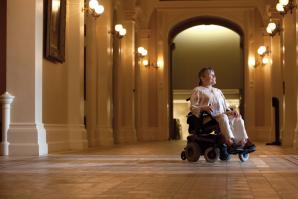If you own, operate, lease or lease to a business that serves the public, the Americans with Disabilities Act applies to you, and you are legally obligated to follow its facility-access guidelines. Here are tips for becoming compliant, protecting yourself against a complaint or lawsuit and getting all the business you can through your doors:
Make upgrades to become compliant immediately. Visit ada.gov for a list of basics that will bring your business into immediate compliance and ward off predatory lawsuits.
Hire a Certified Access Specialist. California certifies inspectors to visit businesses and recommend improvements. Businesses that pass inspection get a sticker to display and retain certain advantages in court proceedings if they are sued. Citizens Against Lawsuit Abuse recommends hiring only a Certified Access Specialist through your attorney and undergoing periodic re-inspection.
The U.S. Small Business Administration also provides information for achieving ADA compliance by removing architectural barriers. The SBA recommends first providing access to the business from public sidewalks, parking and public transportation. Then provide access to areas where goods and services are available. Finally, provide access to public restrooms. You might also need to make it possible for disabled customers to use public telephones and drinking fountains in your business.
Here are some of the basic elements to consider for your disabled customers:
Accessible parking: A designated parking space must have room for the vehicle and another space next to it serving as an access aisle for a person to use a wheelchair or electric scooter. A sign with the international symbol of accessibility is required to be placed high enough so it is not hidden by a vehicle parked in the spot.
Accessible entrance: If you have steps at the entrance, consider eliminating the steps and/or adding a ramp, an alternate entrance or a lift.
Entry doors: Business entries must have a sign with the international symbol of accessibility. Entry doors need to be 36 inches wide and include hardware allowing it to be opened without grasping, pinching or twisting. Usually a lever or electronic door fulfills this requirement.
Turnstiles and entry gates: Narrow turnstiles block wheelchair users, along with people using crutches and walkers. Eliminate turnstiles or offer alternative entrances.
Shelves and maneuvering space: A 36-inch-wide accessible route and a slightly larger space provided around counters are mandated throughout a store. Watch for temporary displays and promotional merchandise that might infringe on the route. All merchandise doesn’t need to be placed within reach of a wheelchair user; however, staff needs to be on hand to retrieve items.
Sales and service counters: At least one of the business’ check stands must be designated for disabled patrons and have signage in plain view. It must also have a shelf or counter no more than 36 inches off the floor, providing an area for a person in a wheelchair to write a check or fill out documents, and a clear space in front of the check stand of at least 30 inches by 48 inches to provide a turning radius for a wheelchair.
Fixed seating and tables: Five percent of tables in an eatery must be accessible and have movable chairs.
The Department of Justice operates a toll-free ADA information line (800-514-0301 voice and 800-514-0383 TDD) to help businesses become compliant. Visit ada.com for recommendations on compliance and calchamber.com for more information on California reform legislation and a list of Certified Access Specialists.
Recommended For You

Access Granted
Failure to comply with disability-access codes can bury your business
When it comes to the issue of accessibility, Sacramento businessman Tony Lutfi knows the drill.
Tenant Tactics
How to plan for tenant improvements
Tightening belts may be the overall theme in commercial real
estate these days, but a little planning can turn into big
savings. Business owners looking for a home and landlords seeking
tenant upgrades can trim expenses without shredding the wish
list.


